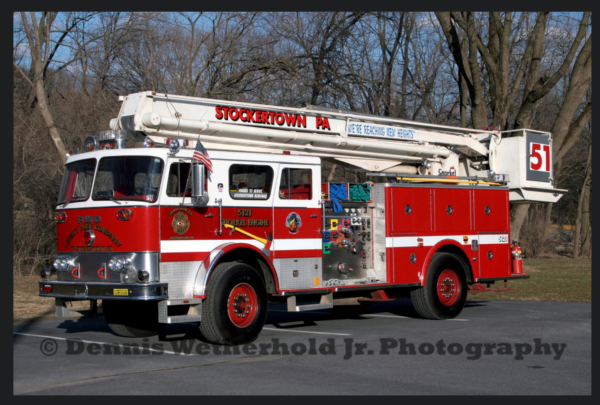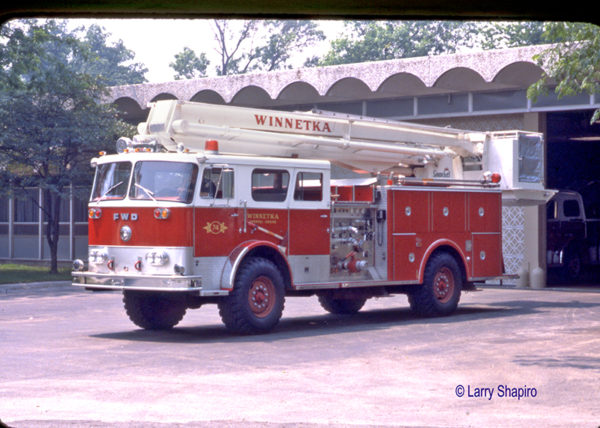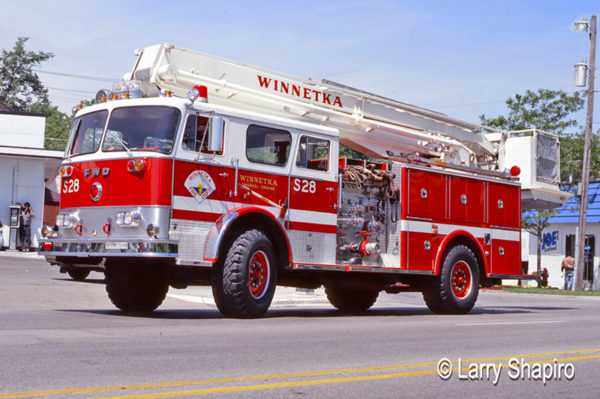From Phil Stenholm:
Another installment about History of Evanston Fire Department
A NEW POLICE / FIRE HQ AND ANOTHER SUDDEN DEATH
A new Seagrave Model J-66 canopy cab 1000-GPM / 80-gallon TCP equipped with a Pierce-Arrow V-12 engine for maximum power, and a Mars FL-8 light on the roof, two high-mounted red flashers, a Delco-Remy Twin-Blast siren, and a bell as warning devices, was placed into service at Fire Station # 1 as the new Engine No. 1 in January 1949, and what had been Engine No. 1 – one of the two 1937 Seagrave Model G-80 canopy cab 750-GPM / 80-gallon pumpers – was transferred to Station # 4, where it became the new Engine No. 4.
Engine Co. 1 continued to respond as the second engine to all structure fires and to inhalator calls city-wide, with Engine Co. 5 remaining the dedicated “high-value district” engine company. Also, the 1917 / 1930 Seagrave Suburbanite 500 GPM / 50-gallon TCP that had been running as Engine No. 4 since June 1947 was placed back into reserve at this time, as the EFD once again had both a pumper (Engine No. 6) and the city service ladder truck (Truck No. 3) in reserve.
Also beginning in January 1949, the Evanston Fire Department no longer provided fire protection to the College Hill section of the Village of Skokie, as the Skokie Fire Department opened its long-awaited east-side Station # 2 at 8340 Hamlin Ave. The new Skokie F.D. Station # 2 was staffed mostly by full-time firefighters, operating with a brand-new 1948 American LaFrance Model 710 PJO 1000-GPM TCP. Together with its Station # 1 at 8031 Floral Avenue in downtown Skokie that was staffed mostly by full-time firefighters operating with a 1937 Pirsch 750-GPM / 60-foot aerial quad and a 1926 Ahrens-Fox 1000 GPM TCP, the Skokie Fire Department was fast becoming a significant north suburban fire department in the post-war years.
At this point in time, the Wilmette Fire Department was partly full-time but still mostly part-time. and it was located in a combined police / fire station built in 1915 at 831 Green Bay Road. Front-line apparatus in Wilmette’s two-bay fire station consisted of a 1942 Seagrave Model G-80 750 GPM TCP and a 1943 Seagrave Model J-66 750-GPM quad, with a 1915 American-LaFrance Model 75 750-GPM TCP in ready-reserve.
The Winnetka Fire Department was located in a very unusual three-bay firehouse at Green Bay Road & Ash Street. The structure was built originally in 1870 as the Academy Hall school, and then it was extensively remodeled and transformed into a fire station in 1925. Like the Wilmette Fire Department, the Winnetka F. D. was partly full-time but mostly part-time in 1949, with a 1947 American-LaFrance Model 775 PGC 750-GPM TCP and a 1926 American-LaFrance Type 14 750-GPM quad in front-line service, and a 1919 American-LaFrance Type 75 750-GPM TCP in ready-reserve.
Built in 1897, the Evanston Police / Fire headquarters at Grove & Sherman was essentially condemned in 1948 due to rampant plumbing problems in the basement cell-block of the police station, and serious structural cracks in the apparatus floor of the fire station. There was also a potential fire hazard related to decomposing 19th century electrical wiring insulation buried deep inside the walls that would have required gutting the interior of the building to replace.
A new two-story Evanston Police / Fire Public Safety headquarters was constructed at the northwest corner of Lake & Elmwood during 1949, and opened for business on August 27th of that year. The old headquarters at Grove & Sherman was torn down almost immediately after the police and fire departments vacated the facility, and the lot was filled-in and leveled and used for more than 25 years as a parking lot for the Valencia theater. An 18-story high-rise office building known as One American Plaza was constructed on the site during 1975-77.
While about 20% larger than its predecessor, the new Public Safety headquarters mirrored the configuration and orientation of the old one. The Evanston Police Department occupied the east side of the facility with an address of 1454 Elmwood Avenue, and the six-bay Fire Station # 1 was located on the west side of the complex at 909 Lake Street.
A brick drill tower was built into the rear of the fire station, replacing the EFD’s old drill tower that had been constructed behind Station # 3 in 1925. The west bay was separated by a brick wall from the rest of the station, and served as the EFD‘s repair shop. The two bays located closest to the repair shop were longer than the other three bays and could easily accommodate aerial-ladder apparatus, with room to spare.
A small two-bay garage for the police ambulance and the prisoner wagon was located on the far northeast corner of the structure facing onto Elmwood Avenue, just a few steps from the EPD’s front desk, where police officers were on duty at all times and available to staff the ambulance when needed. The structure also included a basement parking garage that was used mainly by the police department for vehicle storage, and a basement handball court that was available to both Evanston police officers and firefighters.
On September 20, 1949, EFD Capt. Ed Hanrahan (Engine Co. 1) suffered a fatal heart attack while playing handball in the basement handball court, less than a month after the station opened. Capt. Hanrahan suffered from what is known today as morbid obesity, and playing handball was part of his diet and exercise weight-reduction regimen. A 22-year veteran of the EFD, Hanrahan had served as one of Chief Hofstetter’s buggy drivers prior to being promoted to lieutenant in 1945, and was said to be one of the most popular men in the department.
Capt. Hanrahan was only 44 years old at the time of his death. He was also the fifth EFD officer age 50 or younger to die suddenly of a heart attack since 1929, the other four being 39-year old Lt. Walt Boekenhauer (Engine Co. 4) while on vacation in July 1929, 41-year old Lt. Frank Didier (Engine Co. 2) while off-duty in September 1931, 50-year old Lt. Carl Dorband (Engine Co. 3) while sitting in front of Fire Station # 3 in May 1942, and 43-year old Lt. William Elliott (Truck Co. 1) while on his day off in January 1945.
































